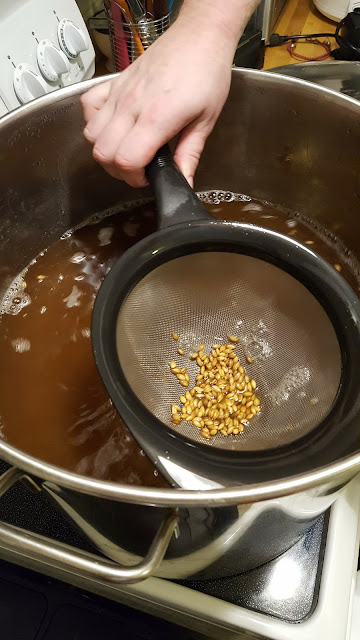First we need to do a little prep work. Keeping everything clean is super important. Star San is a great sanitizer for surface sanitation. The great thing about this product is you do not need rinse it off. Just soak your equipmen or dip your supplies in a solution of this stuff and you are good to go.
Once we get a good boil we can pull the pot off the heat and add the extract. For this beer we are adding 6 pounds of Munton's Plain wheat extract. This extract is 55% wheat and 45% barley.
Once the extract is added we need to stir to make sure it is dissolved well. We also don't want it to stick to the bottom and burn.
Finally we need to cool the wort to ~ 120 degrees Fahrenheit. What makes this beer different than other beers is we have this extra souring step. Normally we would boil some hops, cool, and pitch our yeast. In this case we need to "sour" the beer. A bacteria called Lactobacillus can be added to our wort and will start eating the sugars. In this process it is souring the beer and giving the flavor we are looking for. This bacteria likes to grow between 100 and 120 degrees F and so we need to cool our wort to this temperature. We used a copper coil to get the temperature down. Kirk had a little sump pump to help pump water through the coil and back into the sink.
Once the temperature is down to the correct place, we need to get some Lactobacillus into our wort. This can be accomplished in a number of ways. You can buy cultures. A cheaper way is to buy some wheat grain and throw them into your wort. Wheat naturally harbors Lactobacillus and is a great way to introduce Lactobacillus. A couple hand fulls should be good.
Now we need to create an environment where Lactobacillus grows well and where "bad" bacteria cannot out compete the Lactobacillus. We need to give the wort a cover since it will be sitting here for a few days. Se-ram wrap works great. Get a thick and tight covering over your wort.
We also want to get rid chlorine and chloramine in our water. So adding campden tablets to our water will take care of this.
Next we need to get our water boiling to get it good and sterile. This will be a 5 gallon batch of beer and we are going to go ahead and boil all 5 gallons. Having a pot with a temperature gauge is very helpful. Just don't watch while waiting for a pot to boil. It will go much slower!
Once the extract is added we need to stir to make sure it is dissolved well. We also don't want it to stick to the bottom and burn.
We let the wort sit for 3-4 days at the correct temperature so it can sour. We let it sit on the stove on the simmer setting the entire time and it kept the temperature perfect. You can take a few taste samples at day 2-4 to get it to your desired sour level.
After 3-4 days we can start the next part of the process. First we need to remove all those wheat grains.
Next we are going to do another boil. Our beer is soured and we want to kill any other bad stuff that may be growing in our wort. We also want to add hops. Here are the hops we used.
After the hops boil, we cool the wort again with our cooling coil.
Once we are at the right temperature we are ready to move the wort to the fermentation carboy and pitch our yeast!
We make sure our carboy is sanitized.
Now we pitch! We just used yeast from white labs.
Now we are ready to keg it. We just siphon the beer from the carboy to the kegs. We used two kegs because we were splitting this batch.





























No comments:
Post a Comment